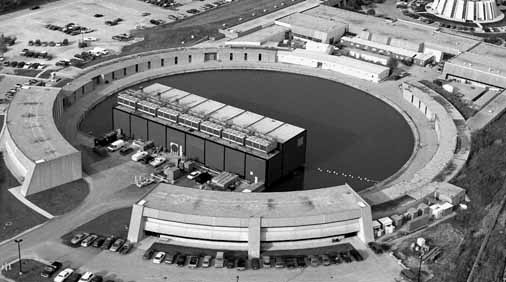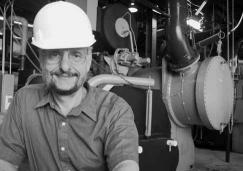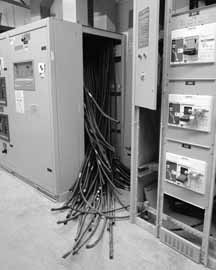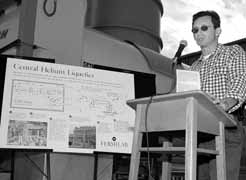 |
|
Ready for Years to Come: New Equipment Saves Energy and Money by Kurt Riesselmann
 Thirty years is a long time for any piece of equipment. Hot water heaters fail before reaching that age. Furnaces are ready for the junkyard even sooner. And your refrigerator? Well, little chance that it will last that long.
Thirty years is a long time for any piece of equipment. Hot water heaters fail before reaching that age. Furnaces are ready for the junkyard even sooner. And your refrigerator? Well, little chance that it will last that long.
Fermilab turned thirty a few years ago. Founded in 1967, the lab has seen its share of failing equipment for both its experiments and the office buildings. Aging cooling and heating equipment are some of the pieces that have caused problems at Fermilab. The electrical feeders, now delivering an average power supply of forty-five megawatts, are another example. In the past few years, the lab recorded about thirty feeder faults per year. Each incident cost the lab about thirty to fifty thousand dollars to fix and may have resulted in interruptions to the lab's scientific program. "The lab has lasted more than 30 years," said Randy Ortgiesen, head of the Infrastructure Management Group of Fermilab's Facilities Engineering Services Section. "During this time, our science program has significantly progressed, but the infrastructure hasn't. We cannot do another thirty years of science without improving the infrastructure. " Innovative Funding Strategy
"UIP presents an alternative funding vehicle for energy efficiency programs and can rebuild critical infrastructure," explained Krstulovich. "It allows labs to work with their utility companies to identify projects that will pay for themselves in less than ten years." Under the UIP program, utility companies provide the initial funding. Reduced utility bills and other avoided costs then allow laboratories to pay for the projects over a ten-year period or less. After this period the labs begin to materialize real savings since most of the new equipment has 20 to 30-year lifecycles. Managers of DOE's Federal Energy Management Program provide support for local workers through training and consultation. They also review each UIP project proposal and contract. Using established DOE protocols, they validate and verify the savings of each project before approval, taking into account changes in lab operations, building functions and number of employees. David Nevin, head of FESS, saw the positive impact that UIP could have. Working with the local DOE office and the lab directorate, he took the initiative to assemble a site-wide audit of all infrastructure needs at Fermilab. Based on its results, he developed the first reinvestment plans. "Replacement of the chillers at the Central Utility Building was the first UIP project at Fermilab," recalled Ortgiesen. "It cost three and a half million dollars and has lead to savings of almost one million dollars per year." Thanks to UIP, engineers replaced old equipment and designed a more reliable and energy efficient system. They separated the old centralized cooling system into two segments: a "comfort system" to cool buildings and office space, and a "process system" to cool accelerator equipment. The system, which has a cooling capacity equivalent to that of about 1,500 homes, uses forty percent less energy and is free of ozone-depleting chlorofluorocarbons (CFCs). If necessary, the new system allows for shifting cooling capacity from the comfort system to the process system, increasing cooling reliability and redundancy for accelerator operations.
Model for other projects The chiller project, which gained Krstulovich a DOE award in 1999, worked so well that the lab decided to use the UIP approach site-wide. The lab provided utility companies access to its facilities. "The two utilities, Nicor and ComEd, spent six months at Fermilab on reviewing our infrastructure," Krstulovich recalled. "They gave us a list of one hundred projects. Next, we encouraged them to think outside the box: `Can we combine projects and eliminate work?' Eventually, we bundled projects and saved millions of dollars by doing things at once. UIP has allowed us to invest 60 million dollars in energy-saving projects." Fermilab has assumed a leadership role in successfully implementing the UIP program. It accounts for more than one third of the 170 million dollars spent on UIP projects at all DOE facilities. The Department of Energy recognized the model character of Fermilab's approach by giving the lab the 2001 DOE Management Award for its Utility Incentive Program. Key projects near completion During the last three years the UIP program at Fermilab has made enormous progress in providing reliable infrastructure that matches the demands of Collider Run II and other scientific projects. "We have made improvements to the three most vulnerable pieces of infrastructure at Fermilab: the electrical power feeders, the Central Utility Building and the Feynman Computing Center," Ortgiesen explained. "We have achieved significant energy savings, lowered the need for maintenance and repairs, and increased the robustness of the infrastructure for science. The UIP is at a peak right now." The Central Utility Building, for example, will receive improvements worth 6.5 million dollars on top of the chiller project. The additional upgrades include the installation of new cooling towers and complete rebuild of the controls and electric systems. Work started in March and is expected to be complete by summer of 2002. "We coordinated the work such that there is minimal impact on accelerator operations," said Ortgiesen. "A lot of work is scheduled during the present shutdown of the accelerators. We have up to seventy people working on the CUB during the shutdown."
Keeping things cool Major upgrades have also taken place at Fermilab's Central Helium Liquefier. The largest facility of its kind in the world, CHL produces liquid helium with a temperature of ñ452 degrees Fahrenheit to cool one thousand superconducting magnets inside the Tevatron accelerator, the world's highest-energy particle accelerator. The CHL facility has seen upgrades worth more than four million dollars in the last four years to meet the increased cooling demands of Collider Run II. Its latest project, the installation of a new compressor and cooling tower, critical elements of the CHL system, will allow operators to reduce power consumption by one megawatt. "The energy we are saving is enough to power four middle schools or 200 households around the clock," said Michael Geynisman. He led the one-million-dollar Compressor C project, which is expected to pay for itself within three years. Geynisman was one of the speakers at a ribbon-cutting ceremony on September 26, which marked the official dedication of the new compressor and tower. At the event, Fermilab director Michael Witherell praised the cooperation between the utility companies and the laboratory. "This is a win-win situation," he said. "We rely on the local industry in many ways. Projects like this one provide our lab with high efficiency and high reliability as we are preparing for a long future ahead of us."
The Department of Energy has recognized the CHL upgrade and its implementation as a model for other laboratories around the country. It named the Central Helium Liquefier an Energy Saver Showcase Facility. It is the second Showcase Award for Fermilab. The Feynman Computing Center received the award in 1996 for its innovative energy conservation design.
More work ahead The UIP program has allowed the lab to address some of the most urgent needs. "We have taken on the highest infrastructure vulnerabilities, but there is still a lot of work to be done," said Ortgiesen. "Unfortunately, the UIP program is not fixing everything. The industrial and domestic water systems, for example, have limited savings and are difficult to bring into the program. " The UIP program has allowed the bundling of projects to use savings related to one system to pay for other infrastructure improvements that by themselves could not be accomplished but are critical to our future. This approach resulted in, for example, a robust power grid with new electrical feeders and added redundancy. Guest scientists have benefited from the UIP program as it has been used to replace old water pipes, providing higher-quality domestic water in the Fermilab village. Even the Wilson Hall kitchen, which is used to prepare meals for more than one thousand people every day, will see improvements. The first phase of a retrofit is taking place right now. On October 16, Fermilab received a DOE Award in recognition of its outstanding energy management, citing its implementation of the Utility Incentive Program. "By necessity, this will become the way to do business for other federal laboratories as well," Ortgiesen said. "The UIP program has provided a much needed boost to our lab's infrastructure. It is a huge step in meeting the needs of the laboratory today and helps position the lab for involvement in future science opportunities." On the Web: FESS Infrastructure Management Group http://www-fess.fnal.gov/IMG/IMGhome.htm Federal Energy Management Program http://www.eren.doe.gov/femp Federal Energy Saver Showcases http://www.eren.doe.gov/femp/prodtech/fed_showcase.html The Central Utility Building Upgrade http://www.eren.doe.gov/femp/utility/fermilab.html |
| last modified 11/9/2001 by C. Hebert email Fermilab |
FRLsDFx9eyfrPXgV
 Fermilab officials recognized the increasing number of problems many years ago, but the budget provided little money to tackle the problems. Comprehensive plans like upgrading the Central Utility Building, which promised to save the lab a lot of money by reducing electricity bills, remained on hold as the lab was struggling to find initial funding. A solution sprang up when Steve Krstulovich, with the help of Assistant Director George Robertson, discovered the Department of Energy's Utility Incentive Program.
Fermilab officials recognized the increasing number of problems many years ago, but the budget provided little money to tackle the problems. Comprehensive plans like upgrading the Central Utility Building, which promised to save the lab a lot of money by reducing electricity bills, remained on hold as the lab was struggling to find initial funding. A solution sprang up when Steve Krstulovich, with the help of Assistant Director George Robertson, discovered the Department of Energy's Utility Incentive Program.
 The UIP program also included work at the Feynman Computing Center. The installation of a new power supply unit minimizes fluctuations in electrical voltage, protecting the Center's extensive computer systems. The new unit also features a backup power generator, making the power supply virtually non-interruptible. Ortgiesen expects the project to be complete before the end of the year.
The UIP program also included work at the Feynman Computing Center. The installation of a new power supply unit minimizes fluctuations in electrical voltage, protecting the Center's extensive computer systems. The new unit also features a backup power generator, making the power supply virtually non-interruptible. Ortgiesen expects the project to be complete before the end of the year.
 Geynisman also noted the excellent cooperation between the utility company, DOE, various Fermilab divisions and the sub-contractors carrying out the installation. Despite very harsh winter conditions, workers completed the project within a very tight schedule.
Geynisman also noted the excellent cooperation between the utility company, DOE, various Fermilab divisions and the sub-contractors carrying out the installation. Despite very harsh winter conditions, workers completed the project within a very tight schedule.